Archive for the 'Board Games' Category
Posted by James (admin) on 16th October 2012
Spiel starts in just a few days. You’d think it would feel less special each time but this is my seventh year and it’s always exciting stuff.

Like last year, I shall be tweeting with some images about what I am playing and see at Spiel. I won’t be trying to review games via Twitter as 140 characters is just not enough in which to do a game justice. So, I will be sharing my general impressions about games, which ones have impressed me, etc. Of course, I shall review games in full once I return from Spiel.
If you’re not following the Metagames twitter, please join the 800 others and follow it now.
James.
Posted in Board Games, Essen Spiel 12 | No Comments »
Posted by James (admin) on 15th October 2012
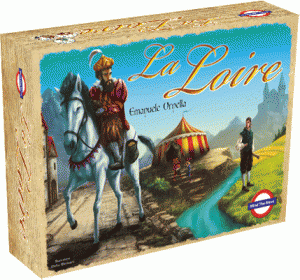 Emanuele Ornella has designed some great games over the last few years (Il Principe, Charon Inc, Assyria). La Loire is his new game this year which looks like a solid euro game. The game is set along the River Loire and players aim to earn as many VPs as possible. Each player has a merchant and a messenger which they move along the roads on both sides of the river – once they start in a direction, they can not go back in the other direction until they reach one of the two cities.
Emanuele Ornella has designed some great games over the last few years (Il Principe, Charon Inc, Assyria). La Loire is his new game this year which looks like a solid euro game. The game is set along the River Loire and players aim to earn as many VPs as possible. Each player has a merchant and a messenger which they move along the roads on both sides of the river – once they start in a direction, they can not go back in the other direction until they reach one of the two cities.
On each turn, the players move their merchant and messenger (in either order) and can take an action at the location each lands on. Players move the number of spaces equal to the number of horses that the piece being moved is on top of (plus 1). The number of horses can change as a player can leave behind any horses they want (any players can use them) or can add one if there are any horses on the space they start from. This sounds like a very interesting game mechanic as you’ll want to help yourself but also hinder others in the taking and leaving of horses.
The core of the game is that the merchant earns the money so that the player can buy messages for the messenger to deliver (or buy boat movement). The merchant’s actions are primarily about buying goods (wood, grain, cheese, wine, beer) and buying buildings. The village location determines what good is available to buy there. Some villages will have farms, monasteries, or castles on them – these are built by the players during the game – and these give discounts (plus beer is only available from monasteries). Read the rest of this entry »
Tags: board game news, Board Games, board gaming, Emanuele Ornella, Essen, La Loire, Mind The Move, Spiel 2012
Posted in Board Games, Essen Spiel 12, La Loire, On the Radar | No Comments »
Posted by James (admin) on 14th October 2012
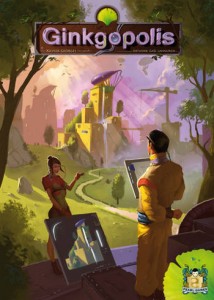 I am very pleased to announce that I am holding my 4th annual game giveaway where I give away one of the new releases from Spiel 2012 which starts in just 5 days time.
I am very pleased to announce that I am holding my 4th annual game giveaway where I give away one of the new releases from Spiel 2012 which starts in just 5 days time.
This year you can win a copy of Ginkgopolis by Xavier Georges (Carson City, Royal Palace, Troyes and Tournay) kindly provided by Z-Man Games.
Visit the competition page for more details on how to enter, and good luck.
Tags: board game news, Board Games, board gaming, Essen, Ginkgopolis, Spiel 2012, Win, Xavier Georges, Z-Man Games
Posted in Board Games, Essen Spiel 12, Ginkgopolis | No Comments »
Posted by James (admin) on 14th October 2012
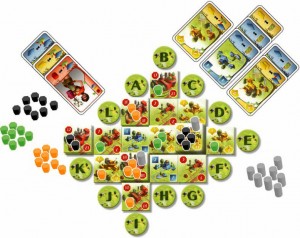 Xavier Georges is one of the designers I really like and it’s good to see he has a new game this year called Ginkgopolis. Carson City, Royal Palace, Troyes and Tournay.
Xavier Georges is one of the designers I really like and it’s good to see he has a new game this year called Ginkgopolis. Carson City, Royal Palace, Troyes and Tournay.
Ginkgopolis is a game of futuristic city building. On their turn, players simultaneously select a card from the 4 cards in their hand. At the end of each round, they will then pass the remaining 3 cards to their neighbour who adds one new card to make a total of 4, and they will select from those on their next turn. That sounds like an interesting card mechanic – sort of like 7 Wonders but continual.
After choosing cards, players resolve their card (which are red, yellow or blue and numbered so each card matches a building). There are three possibilities:
- Gain Resources/Tiles/VPs
Playing a card on its own gains the player resources (their own markers), tiles or VPs (determined by their colour). The amount is based on the height of the matching building (plus bonuses based on items you already gained).
- Build New Building
If the player plays a building tile with their card, they place the new tile where the matching letter is (moving the letter outwards) plus gain any bonuses based on items already gained too. The player places one of their resources (markers) on the building to show their ownership (but this can change during the game). The card matching the new building is added to the draw deck too.
- Develop Existing Building
If the player plays a building tile with their card, they can add the tile to the top of the building shown on the card. The player takes control of the building so they place their marker on it and return any current owner’s markers (for which they get 1VP each) Read the rest of this entry »
Tags: board game news, Board Games, board gaming, Essen, Ginkgopolis, Spiel 2012, Xavier Georges, Z-Man Games
Posted in Board Games, Essen Spiel 12, Ginkgopolis, On the Radar | No Comments »
Posted by James (admin) on 12th October 2012
Shadows Over Camelot Card Game (Days of Wonder)
The original Shadows Over Camelot was an excellent semi co-op game that you could get fairly light gamers to play. The new card game version sounds intriguing as it has many of the same elements but a different core game mechanic. Similar to the board game, it’s co-operative but there may be a traitor. Each turn a player can turn over a card from the deck – many are rumours about the different quests (with icons showing the strength of the rumour) and there are other cards that affect gameplay like players not being allowed to communicate. These cards get added to the ‘threat’ pile. Instead of drawing a new card, a player can choose one of the quest icons on the previously drawn card and go on that quest. This means they sort out the threat pile into the separate quests and activate any Merlin and Morgana cards which can help or hinder the questing player. If the total number of rumour icons for the chosen quest is 11, 12 or 13 then the player succeeds and one of the 7 white swords required to win is gained (otherwise, they gain one of the 7 black swords which will lose the game). However, the rumour icons on the other quests are also added up too and can result in black swords if there are 14+ of their rumour icons. So, it’s a sort of push-your-luck game (with players trying to remember how many icons of each quest have gone past and what other cards are in there too). Like the original game, players can also accuse each other of being a traitor too.
Check out the details and rules at Days of Wonder’s web site: bga.me/soccard
Asgard (What’s Your Game)
What’s Your Game have published some great games in the past (like Vinhos and one of my favourite worker placement games Vasco de Gama). After releasing no new games last year, it’s great to see they have two this year. Asgard is a viking-themed, worker placement game where players place workers (influence) on different locations (gods) with lots of options and interesting decisions. The worker placement is interesting as players secretly select on which gods they will place workers, then take turns revealing one location and placing a worker (which sets the specific action for that god), and then take turns using each worker (and some get benefits for being the first one used on that god). There’s a lot more to it too. For more detailed info, check out my full On The Radar: Asgard piece for more info. Sounds really interesting.
Oddville (What’s Your Game)
Oddville looks like it will contain an interesting mix of tile laying to build a city and using cards to gain resources. Each card can only be used for one of its three uses – cash, resources or buildings – I always like multi-use cards in a game. When players build a building, they place it to expand the city and gain bonuses including gaining characters which give special abilities. At the end of the game, VPs are scored for the buildings each player built (they all score in different ways), characters and remaining resources.
There are some other nice sounding game mechanics too like the way the players pay for resources by putting their worker on one of the limited market prices which determines how much it costs and shows they have that resource until they spend it to build a building. Also, when obtaining a building, the card shows which of the buildings on display are free and which will cost money. So, it sounds like a very interesting and clever eurogame. For more detailed info, check out my full On The Radar: Oddville piece for more info.
James
Tags: Asgard, board game news, Board Games, board gaming, Days of Wonder, Essen, Oddville, Shadows Over Camelot Card Game, Spiel 2012, What's Your Game
Posted in Asgard, Board Games, Essen Spiel 12, Oddville, On the Radar, Shadows Over Camelot Card Game | No Comments »
Posted by James (admin) on 12th October 2012
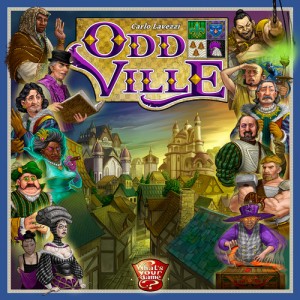 From reading the rules, Oddville looks like an interesting mix of using cards to gain resources and tile-laying to build a city. Now that may sound like a lot of other games but the game mechanics of Oddville look inventive and slick.
From reading the rules, Oddville looks like an interesting mix of using cards to gain resources and tile-laying to build a city. Now that may sound like a lot of other games but the game mechanics of Oddville look inventive and slick.
On your turn, you play 1 card from your hand or build 1 building. When a player plays a card, they can do 1 of the 3 things on the card – gain the cash shown, gain 1 of the resources shown, or gain 1 building from the 6 building cards on display (the card affects the price). I always like games where cards can be used for multiple purposes as it usually creates some interesting decision-making on how to combine the cards best and, hopefully, can be combined differently to give you alternate options if you need to change strategy.
When a player chooses to gain one of the resources on their played card, they place one of their workers on one of the market prices for that resource which are limited in number – this determines how much the resource costs plus the worker shows the player has that resource until they spend it to build a building. This should make for interesting competition over the lowest prices.
When a player chooses to gain a building, their card determines which of the 6 buildings on display are free and which will cost cash – the ones on the left (the oldest) are the ones most likely to be free. This sort of mechanic is in other games (like Gloria Mundi) and I like it because it makes newly added buildings (added to the right-end of the row) generally more expensive. Read the rest of this entry »
Tags: board game news, Board Games, board gaming, Essen, Oddville, Spiel 2012, What's Your Game
Posted in Board Games, Essen Spiel 12, Oddville, On the Radar | No Comments »
Posted by James (admin) on 11th October 2012
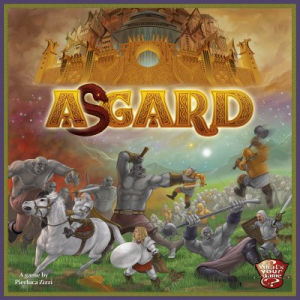 What’s Your Game have published some great games in the past (like Vinhos and one of my favourite worker placement games Vasco de Gama). After releasing no new games last year, it’s great to see they have two this year. Asgard is a viking-themed, worker placement game where players place workers (influence) on different locations (gods) but there’s a lot more to it too and sounds like a meaty eurogame. The board shows the 10 gods (5 light and 5 dark), the various worlds, Asgard and Valhalla.
What’s Your Game have published some great games in the past (like Vinhos and one of my favourite worker placement games Vasco de Gama). After releasing no new games last year, it’s great to see they have two this year. Asgard is a viking-themed, worker placement game where players place workers (influence) on different locations (gods) but there’s a lot more to it too and sounds like a meaty eurogame. The board shows the 10 gods (5 light and 5 dark), the various worlds, Asgard and Valhalla.
The worker placement aspect is a bit different to most worker placement games as players first secretly select on which gods they will place each of their workers (by selecting god cards equal to the number of workers) then they take turns revealing one of their card and placing a worker on one of the available actions of that god (or placing it in Asgard instead if they prefer which has its own benefits), and then they take turns activating one of their workers. (It reminds me a bit of Era of Inventions (a great game from 2011) where players take turns placing their workers and then take turns activating them and the order of activation made a big difference too – but Asgard goes a step or two further.) It sounds like there will be lots of decision-making required as you consider where others will likely place their workers (as there are limited spaces on each god), which actions will work well together, which actions you will need to do before another player, etc. Players will gain and spend workers during the game too so they will need to manage these. Plus, the first worker used on each god earns a light/dark token which are used to buy warriors/giants and new workers (which can trigger battles).
Read the rest of this entry »
Tags: Asgard, board game news, Board Games, board gaming, Essen, Spiel 2012, What's Your Game
Posted in Asgard, Board Games, On the Radar | No Comments »
Posted by James (admin) on 8th October 2012
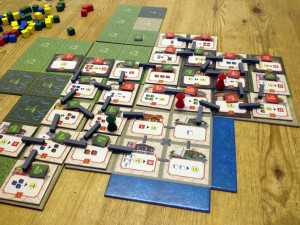 Singapore is an interesting mix of tile-laying and economic/resource management. Players are aiming to score the most victory points (VPs) which are earned through moving your worker(s) and using buildings. The board consists of several sections which can be combined in many ways which gives some variety in replay. Most squares on each board section show the cost of building on that square (£1-£4) . At the start of the game, there are 4 neutral buildings – every round players build one building and connect them to neighbouring buildings.
Singapore is an interesting mix of tile-laying and economic/resource management. Players are aiming to score the most victory points (VPs) which are earned through moving your worker(s) and using buildings. The board consists of several sections which can be combined in many ways which gives some variety in replay. Most squares on each board section show the cost of building on that square (£1-£4) . At the start of the game, there are 4 neutral buildings – every round players build one building and connect them to neighbouring buildings.
Players start with some money, 5 VPs and one worker. At the start of each round, a number of buildings are revealed (equal to the number of players plus one). Then, the player in last place takes one coloured marker from each player and places them on vacant lots that neighbour any existing buildings. These markers show where each player will build a building that round and the cost on the square dictates how much it will cost them.
Starting with the player in last place (and then going clockwise), players select one of the available buildings and pay the cost to build it on their marked square (leaving their coloured marker on it to show they own it). If a player can not afford the building cost, they must exchange 1 VP for £2 until they can (or they get the building for free if they have no cash and no VPs).
Read the rest of this entry »
Tags: board game news, Board Games, board gaming, Peer Sylvester, Singapore, White Goblin Games
Posted in Board Game Review, Board Games, Singapore | 4 Comments »
Posted by James (admin) on 7th October 2012
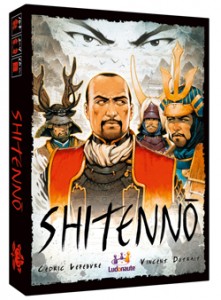 Recently, I reviewed Shitenno and mentioned I thought it would work well as a 2-player game. Since then, I had the chance to try this out and I’m pleased to say it does work well with 2 players as there are fewer combinations of cards and outcomes to try to consider so you can make a more informed decision. Rather than having to make one offer of cards at a time, with two players it is a simple one-player-splits-whilst-the-other-chooses process.
Recently, I reviewed Shitenno and mentioned I thought it would work well as a 2-player game. Since then, I had the chance to try this out and I’m pleased to say it does work well with 2 players as there are fewer combinations of cards and outcomes to try to consider so you can make a more informed decision. Rather than having to make one offer of cards at a time, with two players it is a simple one-player-splits-whilst-the-other-chooses process.
Compared to the 4-player game, I found I could better work out which cards I wanted, plus I had more insight into which cards I didn’t want my opponent to have too. Even with this knowledge, creating a balanced offer of cards/role so that my opponent didn’t automatically take the offer I that really wanted still remained enjoyably difficult. Also, selecting which role is offered with each group of cards is made more interesting because the person making the offer only uses 2 of the 4 roles each turn – in fact, I think I had more difficulty choosing which roles to offer than splitting the cards (in a good way as it was an interesting choice to make).
The inherent downside to a directly competitive 2-player game is that what you lose the other player gains and vice versa (a kind of ‘tug-of’war’ play pattern), and you only need to watch a single opponent. I was thinking that an invisible 3rd player would be good to make things a bit more ‘lumpy’ – I’ve noticed over the years, I like an invisible 3rd player in 2-player game (Alhambra was my first experience of it) but just so long as it is slightly predictable and not purely random. If it’s totally random, one player can suffer through no fault of their own just because they had no way to include the 3rd player’s actions into their plans, and this unbalances the game.
Read the rest of this entry »
Tags: board game news, Board Games, board gaming, Shitenno
Posted in Board Games, Shitenno, Thoughts On | No Comments »
Posted by James (admin) on 3rd October 2012
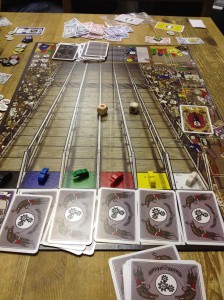 I’m usually a bit skeptical about horse racing games as I find they can be quite dry and/or overly complicated; however, Horse Fever surprised me. In Horse Fever, each player is trying to earn as many victory points (VPs) as possible.
I’m usually a bit skeptical about horse racing games as I find they can be quite dry and/or overly complicated; however, Horse Fever surprised me. In Horse Fever, each player is trying to earn as many victory points (VPs) as possible.
Each round, players get cards, make a bet, play cards on horses (without revealing them), make another bet, reveal the cards and then the race takes place. In the simpler version of the game that we played players are dealt cards – some cards help horses (they get a good start, move further when sprinting, etc.) and some hinder horses (they don’t move when in the lead, all beneficial cards are ignored, etc.) In the full version of the game, players buy cards instead of bring dealt them (which I think would be the best way) – you can also get target cards (extra VPs if you meet the conditions at the end of the game), assistant cards (discounts on some cards, regular income, etc.), stable cards (you own a horse and get cash if 1st, 2nd or 3rd), horse cards (on-going benefit to your horse if you have a stable). You can also take out loans and buy cards from other players. Read the rest of this entry »
Tags: board game news, Board Games, board gaming, Horse Fever
Posted in Board Game Review, Board Games, Horse Fever | 3 Comments »
![]()









